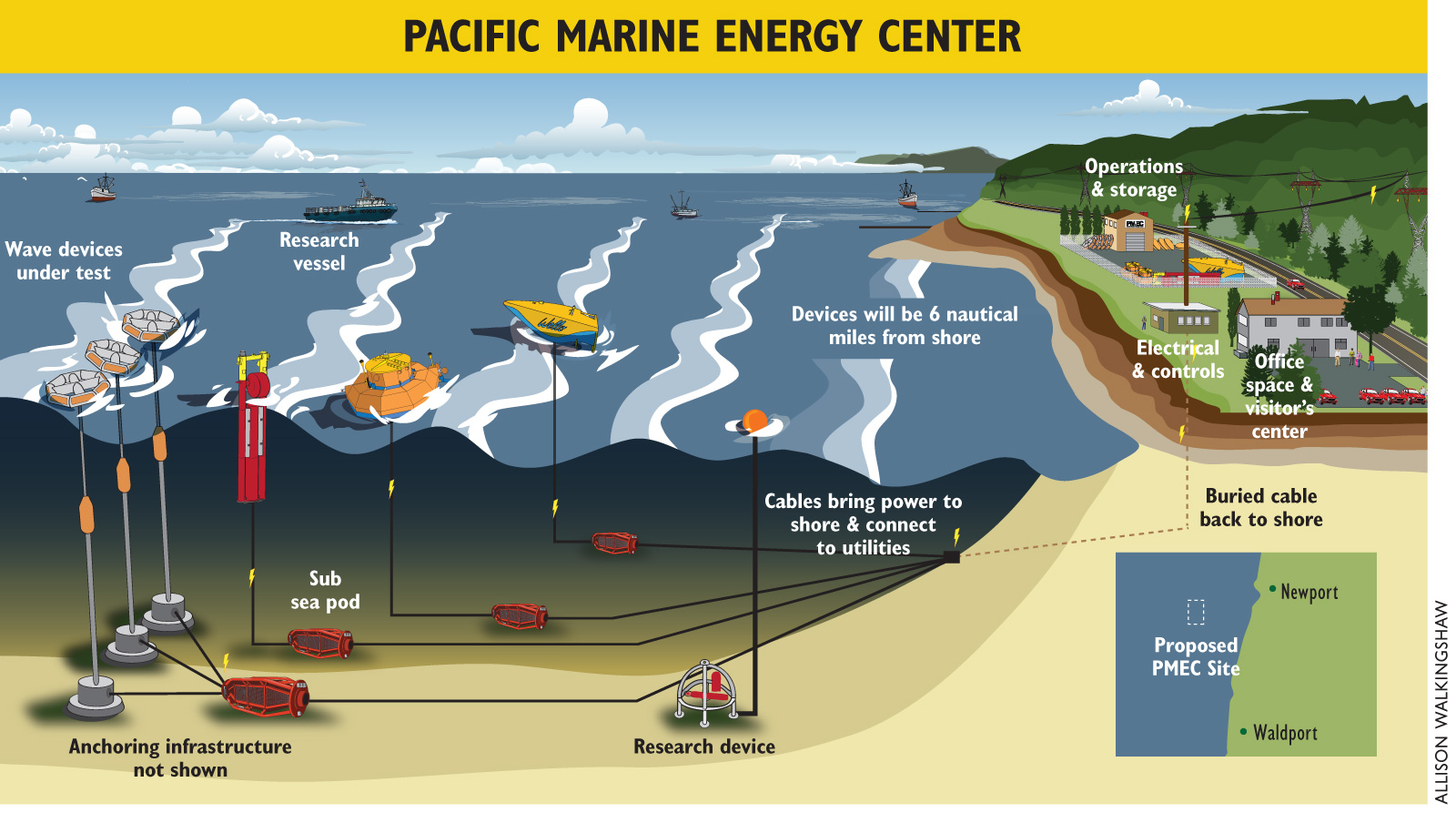 Oregon forges ahead in low-emissions transportation and green-materials research, holds steady on green building and battles uncertainty in the renewable energy and clean-tech manufacturing markets.
Oregon forges ahead in low-emissions transportation and green-materials research, holds steady on green building and battles uncertainty in the renewable energy and clean-tech manufacturing markets.
BY PETER BARNES
 Since passing groundbreaking laws on urban growth and conservation in the 1970s, Oregon has earned a national reputation for its dense web of environmental-protection initiatives. Some 40 years later, the race is on to transform that eco-friendly image into a driving force in the 21st-century low-carbon economy.
Since passing groundbreaking laws on urban growth and conservation in the 1970s, Oregon has earned a national reputation for its dense web of environmental-protection initiatives. Some 40 years later, the race is on to transform that eco-friendly image into a driving force in the 21st-century low-carbon economy.
The results, measured by job growth, investment, innovation and environmental impact, vary by sector. In transportation, Oregon has become a leader in electric-vehicle infrastructure and cycling. In construction and scientific research, it remains a fount of green-materials development and innovative design, although other states are fast catching up in terms of efficient building. Oregon utilities are meeting benchmarks for renewable power but face more challenging targets in the next decade. Meanwhile, the state’s green-tech manufacturing stands at an inflection point, successful in attracting companies to the state yet vulnerable to the rapid consolidation in solar and wind.
In Oregon the number of private-sector green jobs — defined by the Bureau of Labor Statistics as work that provides goods or services that benefit the environment or conserve natural resources — increased 22% from 2010 to 2011, accounting for nearly 50,000 positions across 10 sectors. That represents 3.7% of the state’s workforce: an indisputably small element that nonetheless helped catapult Oregon to the top of the “Clean Jobs Index” this year, a state ranking compiled by the Denver-based Ecotech Institute measuring retention and creation of green jobs.
Known for confronting environmental challenges early and aggressive pursuit of green businesses, Oregon likes to dash in front of the pack. Sometimes it trips over itself in the process — perhaps best evidenced by the spate of heavily subsidized solar companies that have cut jobs since the beginning of the year. Indeed, after spending $343 million in the past four fiscal years to finance energy conservation, renewable power and green development via the Business Energy Tax Credit (BETC), the state dissolved the program last year amid accusations that participants were splitting up projects to maximize their take.
Aiming to scale its green growth, limit environmental impacts and maintain a competitive edge in an era marked increasingly by austerity, Oregon and its standing in the green economy are best judged in the sectors where the state has invested the most: construction, transportation, manufacturing, utilities and research. Here is a snapshot of the accomplishments, the setbacks and the challenges ahead.
Building: Innovation vs. implementation
| Number of green jobs: 6,067 |
For decades the state has been at the forefront of green construction trends aiming to reduce emissions from building activity. (Residential and commercial building accounts for about 35% of greenhouse-gas emissions in Oregon.) Yet other states are fast catching up.
In the mid-1970s, Oregon was among the first in the nation to incorporate energy conservation into its building codes. The rules have been tightened regularly, with the most recent code resulting in new buildings 10% to 15% more efficient than those built under the 2008 and 2007 rules. In recent years, though, such regulations have become less exceptional in a national context. Spurred by requirements attached to $3.1 billion in federal stimulus money through the 2009 State Energy Program, all but nine states now have an efficiency code, and many others meet the 2009 International Energy Conservation Code that formed a baseline for Oregon’s current standards.
Under Senate Bill 79, passed in 2009, Oregon also developed a “reach” code that builders can meet to exceed mandated efficiency standards. However, the Oregon Building Codes Division could not identify any commercial buildings certified under the voluntary standards.
Oregon ranked fifth for new LEED-certified space per capita in 2010 but then fell out of the top 10 states in 2011 and 2012. Building experts pointed to a surge in federal construction projects in the D.C. area, as well as regional variations in the U.S. construction market and changes to Oregon’s incentive programs in explaining the change. Still, Oregon’s green-building sector generates about $27 billion annually, according to the Cascadia Green Building Council.
Much of Oregon’s prominence in the sector resides at the project level. Last year Painters Hall in Salem became one of a handful of buildings worldwide recognized by the International Living Future Institute for net-zero energy use. In Portland’s South Waterfront district, the SERA Architects-designed Collaborative Life Sciences Building incorporates a 50,000-gallon rainwater tank for toilets and other non-potable use.
Not all ambitious buildings have left the drawing board. The Oregon Sustainability Center, a public/private partnership, was intended to be the country’s first office high-rise to meet the zero-impact aspirations of the Living Building Challenge. Efforts to get the center off the ground fell apart last fall after the legislature and the Portland City Council failed to support the $50 million project.
Oregon continues to lead the country in green-building innovation, says Nick Hartrich, Cascadia’s community engagement manager.
He pointed to Portland’s pioneering work on “ecodistricts,” which take a neighborhood, instead of building-based, approach to reducing energy impacts. The city is home to five designated ecodisctricts: communities working to coordinate waste management, transportation, renewable energy, energy efficiency, and district heating and cooling to improve sustainability. Despite these advances, roadblocks to green growth persist, and “capital is always at the top of that list,” Hartrich observes.
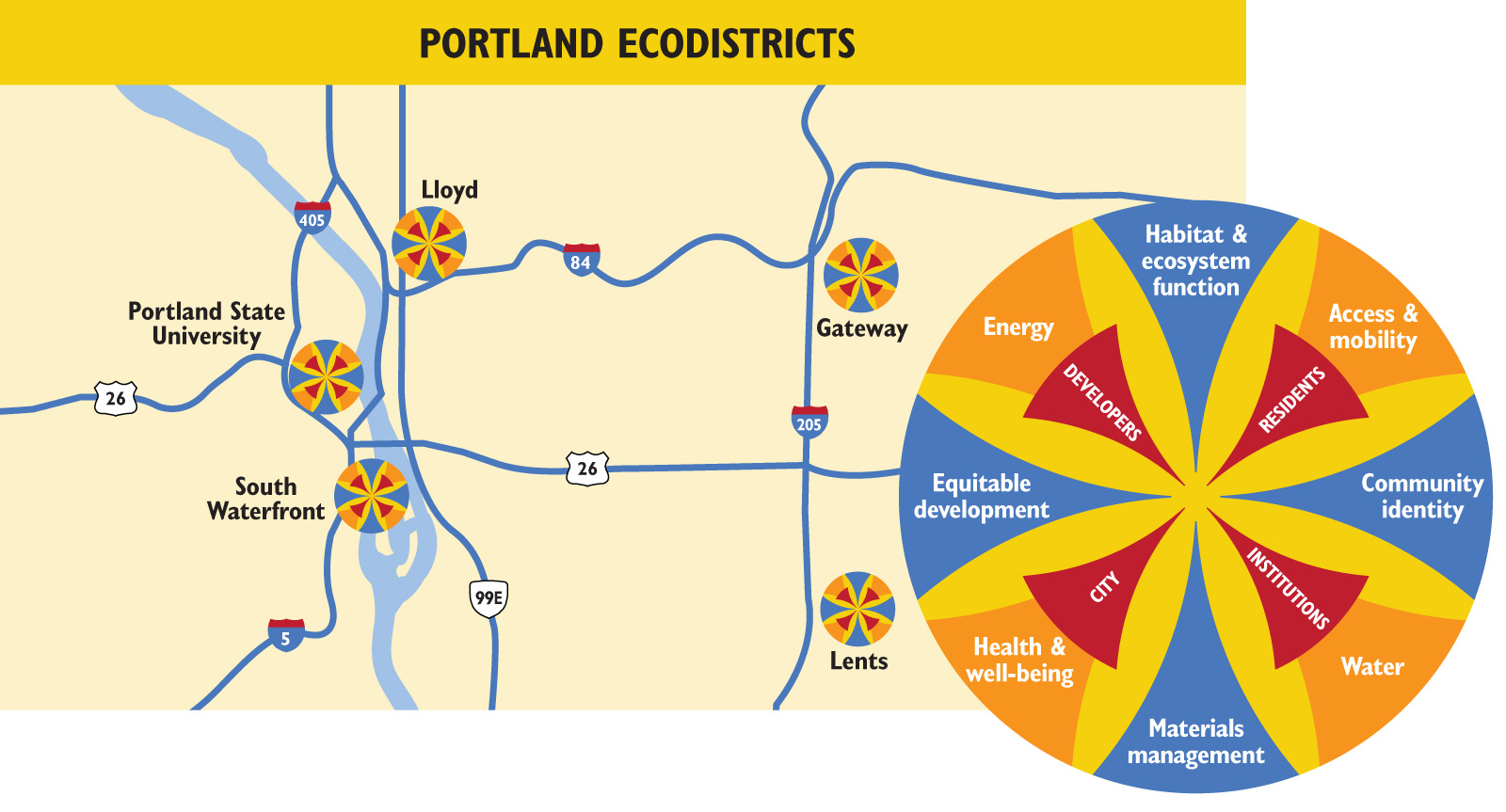
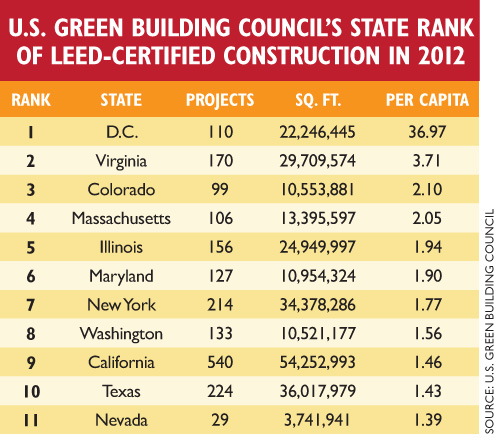
Utilities: The conservation solution
| Number of green jobs: 407 |
In 2010 more than 120,000 Oregon electric customers chose to pay a little extra on their power bills to support renewable energy. Only Texas, with more than six times the population, signed up more people for so-called green pricing, according to the U.S. Energy Information Administration. When it comes to cutting carbon and conserving power, Oregon’s electric customers put their money where their mouth is. Governor Kitzhaber’s 10-year Energy Action Plan aims to offset all electrical load growth with conservation, and so far Oregon is on track. That’s thanks in part to laws dating back to 1999 requiring the state’s largest utilities to divert about 5% of revenues to conservation. The Energy Trust of Oregon uses those funds to incentivize weatherization, small-scale renewable power and the purchase of efficient appliances. Since 2002 those efforts have saved 368 megawatts, helping Oregon reduce electricity consumption even as its population grew.
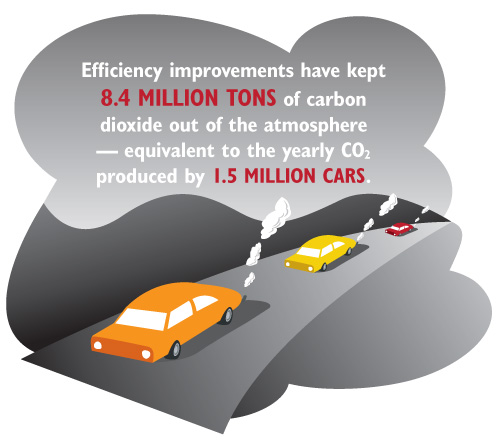 “We’re buying energy through efficiency at 2.5 cents a kilowatt hour, a third of the cost for electricity and less than two-thirds the cost for natural gas,” says Margie Harris, Energy Trust’s executive director. “So we’re getting a very fine deal.”
“We’re buying energy through efficiency at 2.5 cents a kilowatt hour, a third of the cost for electricity and less than two-thirds the cost for natural gas,” says Margie Harris, Energy Trust’s executive director. “So we’re getting a very fine deal.”
Additionally, Clean Energy Works Oregon has given homeowners $2.7 million in rebates for about 2,400 residential energy upgrades since 2011. The nonprofit is bringing down energy use in 19 counties by leveraging $20 million in federal stimulus funding.
Oregon also aims to cut the environmental impact of its utilities through renewable portfolio standards. By generating or acquiring electricity from renewable sources equivalent to 16.9% of its Oregon load in 2011, Portland General Electric blew past its 5% RPS target for that year, according to the state’s Public Utility Commission. So did Pacific Power, with 13.5% green generation.
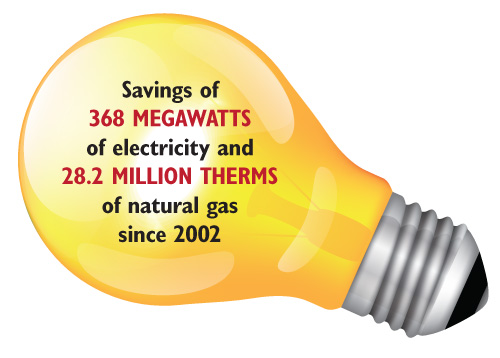 The electricity market is not confined to state borders, though. About 80% of the electricity generated in Oregon comes from hydro plants and other renewable sources, but much of that clean power is exported to utilities meeting renewable portfolio standards in other states. For example, Southern California Edison purchases all the power generated by the 845-megawatt Shepherds Flats wind-energy project in eastern Oregon.
The electricity market is not confined to state borders, though. About 80% of the electricity generated in Oregon comes from hydro plants and other renewable sources, but much of that clean power is exported to utilities meeting renewable portfolio standards in other states. For example, Southern California Edison purchases all the power generated by the 845-megawatt Shepherds Flats wind-energy project in eastern Oregon.
According to the Oregon Department of Energy, 35.5% of the power Oregonians use still comes from coal, and another 16.2% comes from natural gas. Oregon’s renewable portfolio standard will eventually bring those percentages down as the state aims to consume 25% of its power from renewable sources by 2025. But in doing so, it will likely face competition for green energy from other Western states with similar targets.
Transportation: Growing bikes, trains and electric vehicles
| Number of green jobs: 2,640 |
Oregon, and Portland in particular, have earned a national reputation for promoting innovative approaches to cycling, transit and other low-emission transportation — even in urban landscapes that, like the rest of America, are still dominated by cars.
In 2011 bicycling represented an average of 2.8% of all trips across the Portland metro area, with that figure ranging as high as 9.8% in parts of Portland proper. Bike commuting (trips taken solely for work purposes) more than quadrupled to 4.6% — some 50,000 rides daily — since the survey was last conducted in 1994. Those figures remain meager compared to the city’s goal to make bikes account for a quarter of all trips by 2030, yet Portland is in a leading national position when it comes to bicycles’ share of traffic.
Regional investment in bike infrastructure appears to be paying off. A study released in May by Travel Oregon, the state’s tourism agency, found that bicycle tourism injects $400 million annually into the Oregon economy.
Despite a rash of service cuts and fare increases in the past few years, the state’s predominant transit agency tells a similar story of growth. The agency’s 2011 per-capita ridership was seventh in the nation, despite Portland being the 24th largest metro area in the country. Fourth-quarter 2012 data from the American Public Transportation Association confirms TriMet’s average weekday ridership is comfortably above that of similarly sized cities like Sacramento and San Antonio, and even above much larger metros like San Diego and Houston.
Oregon governments have committed significant resources to expanding transit rail systems, pitching in roughly half the cost of the $148 million extension of the Portland Streetcar and a $745 million investment in the $1.5 billion Portland-Milwaukie light-rail extension. These efforts, however, faced significant opposition from many residents and public officials disputing the projects’ usefulness.
In other low-carbon transportation, Oregon has assembled significant funding for electric vehicles, including $700,000 in federal stimulus funding and $2 million from a federal TIGER II grant to build an extensive network of fast chargers. More than 2,000 electric vehicles are registered here — up from 400 in 2010 — and only Hawaii has more charging stations per capita. A Northwest Economic Research Center study released in January estimated the state’s electric vehicle industry generates $267 million in gross economic activity and employs more than 400 people.
In Oregon the transportation of people and goods accounts for the largest share of greenhouse-gas emissions — about 38%. But that number is flattening, and not just because the recession caused a reduction in vehicle miles driven, says Angus Duncan, chair of Oregon’s Global Warming Commission. “We’re seeing people drive less and drive more efficient cars.” Duncan notes the state has set a 2050 goal of reducing greenhouse gas emissions by at least 75% below 1990 levels. “We think we have a fighting chance of getting there,” he says. “That’s in part because we expect zero-emission and electric vehicles to be a dominant form of transportation.”
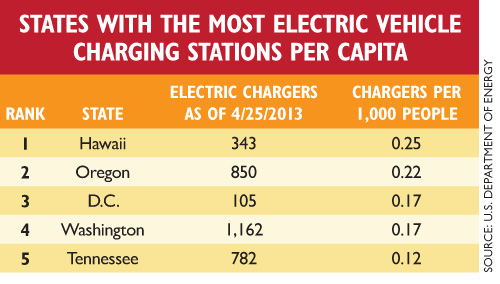
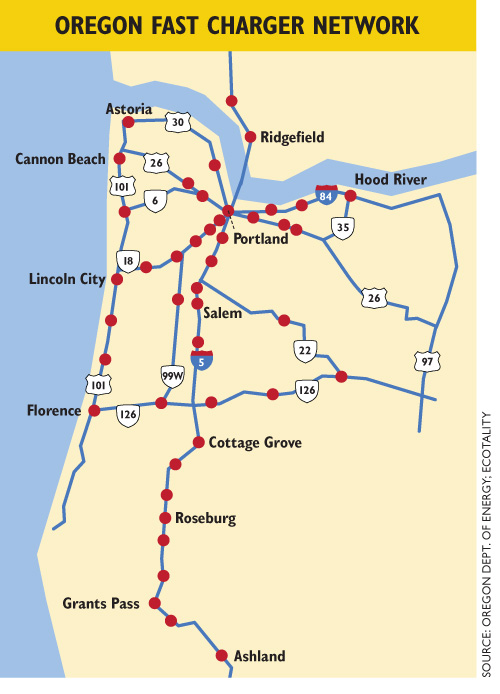
Manufacturing: Navigating shifting markets and subsidies
| Number of green jobs: 15,564 |
By 2011 the Portland Metro Climate Prosperity Project proudly noted that Oregon had created the largest concentration of solar manufacturers in the country. Capital totaling $1.5 billion flowed into the sector, according to Business Oregon, encouraged by government incentives to grow clean-tech industries that became a focal point of economic policy at the White House and the statehouse alike.
The results in the Portland region are real. According to the Portland Development Commission, Multnomah County alone is home to more than 12,000 clean-tech jobs created mostly over the last decade. Yet the state’s success in recruiting manufacturers like SolarWorld and Solaicx to the Portland area and Sanyo Solar to Salem has also meant exposure to young industries with volatile pricing, voracious Chinese competition, and a susceptibility to shocks as subsidies for renewable power shift with the sentiments of elected officials.
Danish wind-turbine company Vestas’ margins dropped sharply in 2011, partly on uncertainty surrounding a key federal production tax credit set to expire this year. The company rewrote its business plan and shed more than a fifth of its global workforce last year, including an undisclosed number of positions at the company’s North American headquarters in Portland.
“Ultimately, we have to figure out what the sustainable long-term U.S. market looks like in terms of megawatts and size,” says Vestas Americas president Chris Brown. “The industry is still sorting that out.”
In the solar industry, system prices fell 27% last year on the heels of similar price drops in previous years. That’s pushed up demand but also triggered a global consolidation. SoloPower recently notified the state it plans to shut down its Portland operations in June. Sanyo Solar announced 52 Oregon layoffs in April, and shortly afterward Germany-based SolarWorld, which employs about 700 in Hillsboro, began restructuring its debt to address a $624 million 2012 net loss.
Other parts of clean tech appear poised for further manufacturing growth as Oregon continues to attract startups in electric vehicles and energy storage. Last year, EnerG2 opened a 74,000-square-foot manufacturing plant in Albany. It’s expected to employ upwards of 50 people producing a nanotech carbon material that allows greater energy storage for batteries and other applications. “I’m seeing Oregon as being fairly successful in attracting these types of new businesses and being a source of innovation,” says Chris Wheaton, EnerG2’s chief operating and financial officer.
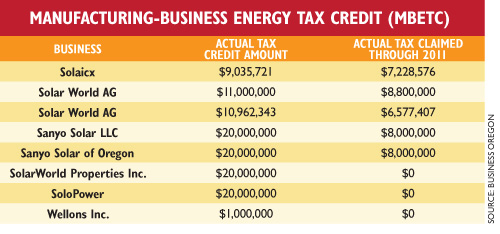
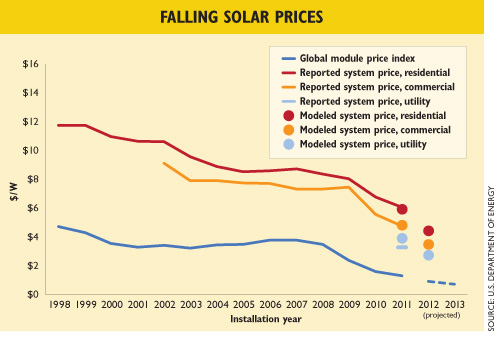
Science and research: Driving jobs and the new economy
| Number of green jobs: 5,075 |
Oregon’s scientists are hardly alone in pursuing green projects, but the state brings a lengthy track record in promoting the research that can lead to green jobs. One of the best-known initiatives is the Oregon Built Environment and Sustainable Technologies Center (BEST), first funded by the legislature in 2007. Since then, more than 200 scientists affiliated with Oregon BEST have brought $93 million in federal and other research dollars to the state. The organization’s commercialization program also offers grants and support to startups such as Shelter Works, which makes recycled wood-cement blocks, and HM3 Energy, which has developed a coal alternative from forest and agricultural waste.
Other green laboratory strengths include the Center for Sustainable Materials Chemistry — a collaboration led by two Oregon universities and awarded a $20 million National Science Foundation grant in 2011. Likewise, the newly established Pacific Marine Energy Center in Newport plans to build the only utility-scale, grid-connected wave power test site outside of Europe, backed by $4 million in matching funds from the federal Department of Energy. “Oregon is uniquely positioned to take on this role,” says Belinda Batten, director of the Northwest National Marine Renewable Energy Center, which is overseeing the project.
She cites the region’s power-transmission infrastructure, manufacturers experienced with marine components and the knowledge base at Oregon State University — recognized globally as a leader in the field. Professionals outside of academia, like the seven Corvallis-based environmental consultants of Dutch firm Ecofys, also benefit from Oregon’s demand for engineering, policy research and technical services.
Since 2008 the company’s clients have included the Oregon Wave Energy Trust, PGE and the Energy Trust of Oregon as they sized up the technical challenge of tying new renewable power into the existing grid. “There definitely is a good, fertile market here,” says Ecofys U.S. managing director Diane Broad.
Oregon has nurtured that market with decades of progressive environmental policies and millions in public investment in sustainable industries. Whether all of the resulting businesses are sustainable themselves remains to be seen. Oregon’s leadership faces challenges in the form of shifting clean-energy subsidies, stiff competition for renewable business and disagreement around clean-energy legislation.
As this article went to press, the state legislature was engaged in a contentious debate over the Clean Fuels program, which would mandate a 10% carbon reduction in car and truck fuel by 2025. Oregon’s commitments to renewable power, low-carbon transportation and clean technology paint a picture of a state as green as any. Translating these commitments into consistent, long-term economic and environmental gains will challenge Oregon for years to come.
